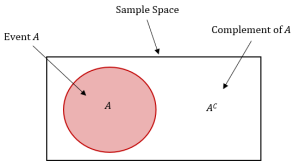3.3 The Complement Rule
LEARNING OBJECTIVES
- Calculate probabilities using the complement rule.
The complement of an event [latex]A[/latex] is the set of all outcomes in the sample space that are not in [latex]A[/latex]. The complement of [latex]A[/latex] is denoted by [latex]A^C[/latex] and is read "not [latex]A[/latex]."
EXAMPLE
Suppose a coin is flipped two times. Previously, we found the sample space for this experiment: [latex]S=\{HH, HT, TH, TT\}[/latex] where [latex]H[/latex] is heads and [latex]T[/latex] is tails.
- What is the complement of the event "exactly one head"?
- What is the complement of the event "at least one tail."
Solution
- The event "exactly one head" consists of the outcomes [latex]HT[/latex] and [latex]TH[/latex]. The complement of "exactly one head" consists of the outcomes [latex]HH[/latex] and [latex]TT[/latex]. These are the outcomes in the sample space [latex]S[/latex] that are NOT in the original event "exactly one head."
- The event "at least one tail" consists of the outcomes [latex]HT[/latex], [latex]TH[/latex], and [latex]TT[/latex]. The complement of "at least one tail" consists of the outcomes [latex]HH[/latex]. These are the outcomes in the sample space [latex]S[/latex] that are NOT in the original event "at least one tail."
TRY IT
Suppose we roll a fair six-sided die with the numbers [latex]1, 2, 3, 4, 5, 6[/latex] on the faces. Previously, we found the sample space for this experiment: [latex]S=\{1,2,3,4,5,6\}[/latex]
- What is the complement of the event "rolling a 4"?
- What is the complement of the event "rolling a number greater than or equal to 5"?
- What is the complement of the event "rolling a even number"?
- What is the complement of the event "rolling a number less than 4"?
Click to see Solution
- The complement is [latex]\{1,2,3,5,6\}[/latex].
- The complement is [latex]\{1,2,3,4\}[/latex].
- The complement is [latex]\{1,3,5\}[/latex].
- The complement is [latex]\{4, 5, 6\}[/latex].
The Probability of the Complement
In any experiment, an event [latex]A[/latex] or its complement [latex]A^C[/latex] must occur. This means that [latex]\displaystyle{P(A)+P(A^C)=1}[/latex]. Rearranging this equation gives us a formula for finding the probability of the complement from the original event:
[latex]\begin{eqnarray*}P(A^C)&=&1-P(A)\\\\\end{eqnarray*}[/latex]
EXAMPLE
An online retailer knows that [latex]30\%[/latex] of customers spend more than [latex]\$100[/latex] per transaction. What is the probability that a customer spends at most [latex]\$100[/latex] per transaction?
Solution
Spending at most [latex]\$100[/latex] ([latex]\$100[/latex] or less) per transaction is the complement of spending more than [latex]\$100[/latex] per transaction.
[latex]\begin{eqnarray*}P(\text{at most \$100})&=&1-P(\text{more than \$100})\\&=&1-0.3\\&=&0.7\end{eqnarray*}[/latex]
TRY IT
At a local college, a statistics professor has a class of [latex]80[/latex] students. After polling the students in the class, the professor finds out that [latex]15[/latex] of the students play on one of the school's sports teams and [latex]60[/latex] of the students have part-time jobs.
- What is the probability that a student in the class does not play on one of the school's sports teams?
- What is the probability that a student in the class does not have a part-time job?
Click to see Solution
- [latex]\displaystyle{P(\text{no sports team})=1-P(\text{sports team})=1-\frac{15}{80}=0.8125}[/latex]
- [latex]\displaystyle{P(\text{no part-time job})=1-P(\text{part-time job})=1-\frac{60}{80}=0.25}[/latex]
Exercises
- Suppose a coin is flipped three times.
- Find the sample space for this experiment.
- What is the complement of the event "exactly 1 tail"?
- What is the complement of the event "at most 2 heads"?
- What is the complement of the event "2 or more tails"?
Click to see Answer
- [latex]\{HHH, HHT, HTH, THH, TTH, THT, HTT, TTT\}[/latex]
- [latex]\{HHH, TTH, THT, HTT, TTT\}[/latex]
- [latex]\{HHH\}[/latex]
- [latex]\{HHH, HHT, HTH, THH\}[/latex]
- A 12-sided die is in the shape of a regular dodecahedron. The faces of the 12-sided die are labelled with the numbers 1 to 12. Suppose the 12-sided die is rolled one time.
- Find the sample space of this experiment.
- What is the complement of the event "rolling a 7"?
- What is the complement of the event "rolling a number less than or equal to 9"?
- What is the complement of the event "rolling a number that is a multiple of 3"?
- What is the complement of the event "rolling a 5 or 9 or 12"?
- What is the complement of the event "rolling a number greater than 8?"?
- What is the complement of the event "rolling an odd number"?
Click to see Answer
- [latex]\{1, 2, 3, 4, 5, 6, 7, 8, 9, 10, 11, 12\}[/latex]
- [latex]\{1, 2, 3, 4, 5, 6, 8, 9, 10, 11, 12\}[/latex]
- [latex]\{10, 11, 12\}[/latex]
- [latex]\{1, 2, 4, 5, 7, 8, 10, 11\}[/latex]
- [latex]\{1, 2, 3, 4, 6, 7, 8, 10, 11\}[/latex]
- [latex]\{1, 2, 3, 4, 5, 6, 7, 8\}[/latex]
- [latex]\{2, 4, 6, 8, 10, 12\}[/latex]
- A recent survey asked people about home ownership and annual income. A total of [latex]750[/latex] people were surveyed. Of the [latex]750[/latex] people surveyed, [latex]425[/latex] owned a home. Of the [latex]750[/latex] people surveyed, [latex]338[/latex] people had an annual income of [latex]\$60,000[/latex] or more.
- What is the probability that one of the people in the survey does not own a home?
- What is the probability that one of the people in the survey has an annual income of less than [latex]\$60,000[/latex]?
Click to see Answer
- [latex]0.4333[/latex]
- [latex]0.5493[/latex]
- A local college surveyed its recent graduates about their overall satisfaction with their college experience and employment status post-graduation. In the survey, [latex]75\%[/latex] of respondents said they were satisfied with their college experience, and [latex]64\%[/latex] of respondents said they found full-time jobs after graduation.
- What is the probability that a respondent was not satisfied with their college experience?
- What is the probability that a respondent did not find full-time jobs after graduation?
Click to see Answer
- [latex]0.25[/latex]
- [latex]0.36[/latex]
"3.4 The Complement Rule" and “3.8 Exercises” from Introduction to Statistics by Valerie Watts is licensed under a Creative Commons Attribution-NonCommercial-ShareAlike 4.0 International License, except where otherwise noted.


